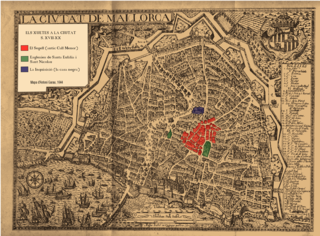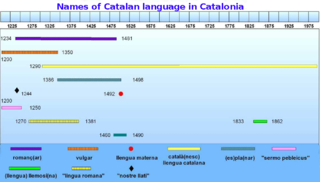
Inca is a town of 30,000 inhabitants located at the center of the island of Majorca in the Spanish province of Islas Baleares.

Inca is a town of 30,000 inhabitants located at the center of the island of Majorca in the Spanish province of Islas Baleares.
A Jewish population is known to have existed on Inca since Jaume I conquered Majorca in 1229, although their presence had already been reported by Severus, bishop of Menorca, in the 5th century.
The origin of the Jewish quarter (named call in Catalan) dates from a 1346 order issued by king Peter IV of Aragon upon request from the Governor of Majorca, Gilabert de Centelles, because of disturbances caused by the mostly Christian inhabitants of Inca, who were displeased with the widespread presence of Jews in the town.
The Governor's lieutenant, Berenguer de Oms, aided by an advisor, made the first proposal for a location for the Jewish quarter. The Jewish community directly informed the king about their refusal of the proposed location because the place known as "Carrer d'en Prats" had houses in utter disrepair. King Peter IV agreed and informed Gilabert de Centelles about the reservations the Jews had about the place, and ordered that a legal expert trusted by the community be appointed to pick a proper location.
Because Gilabert de Centelles was due to travel to Valencia and Catalonia on royal business, he delegated the task on Guillermo de Lagostera, who arrived at Inca in 1353 together with legal expert Ramon de Capeir as well as Jaume de Buadella, who was a jury in Palma. They met with the juries of Inca and the secretaries of the aljama and reached an agreement on the place called "Carrer d'en Pascolet."
From then on, economic troubles began. The already existing houses were confiscated, and Jews were charged a price for them that owners did not accept. A period of almost 24 years of constant reclamations to the Governor and to the King ensued. The King decreed that the difference between the appraised value of the houses and the amount paid for them would need to be covered by the University of Inca, which sparked confrontations between house owners and the university.
A committee of two Christians and two Jews was appointed to negotiate the sale and rent prices for the houses in the call, but the University sent a written complaint to the King and the whole process was paralyzed for 10 years. The Governor then gave the order to comply with the King's mandate and resume the process, but it was not actually done until 1363, under new Governor Bernardo de Tous. A new appraisal committee, with two Christians named Montroig and Palou, and two Jews named Faquim and Fallux, was chosen.
No written record of the place exists between 1363 and 1372. It is known that the previous owners of the confiscated houses appealed to the authorities with new complaints about the prices.
In 1372, the secretaries of the aljama filed a complaint because routine attacks by Christians on Jews were pushing Jews to leave. Governor Tous ordered the building of two gates to keep the Jewish quarter enclosed so Christians would not assault Jews. Until then only one gate had existed, called En Reboll.
Jews are believed to have taken possession of the call between September and October 1372.
In 1391, at the time when Christians were launching attacks on Jewish communities in Aragon and Castile, the ones in Inca and Palma suffered a similar fate, and houses and businesses were burned down.
The Jewish quarter of Inca can be considered the secondary aljama of Majorca. The main one was in Palma, but beginning in 1383 the secretaries of the aljama in Palma delegated functions on their peers in Inca, making the community effectively independent. This arrangement was short-lived as the neighborhood was destroyed in 1391 and most of the survivors converted to Christianity.
All evidences indicate that the call had a synagogue. In documents from 1392, convert Bartomeua claimed inheritance rights on properties owned by her grandfather "Jucef Ben Baharon, rabbi of the Jewish School of the Call."
In the town map made by Dr. Sebastià Sans in 1808, the Jewish quarter appears as "El Call" and numbered with 10.
Based on an investigation conducted by Antoni Ginard, Joan Estrany and Francesca Tugores at the University of the Balearic Islands, Jeroni de Berard is currently believed to have made in 1790 the oldest map of Inca, later used by his sometimes collaborator Sebastià Sans to make his own in 1808.
The owners of the house of Can Monroig, formerly known as Can Mora, carried out a process of total restoration. During the excavation, they found architectural remains and pottery likely dating from the call or Muslim times.

The Jewish call can be found between Sant Francesc, Virtut, Can Valella, Pare Cerdà, El Call, and La Rosa streets.
Approximately 306 people are estimated to have lived in the call, most of which worked in crafts and trading.

Mallorca, or Majorca, is the largest island in the Balearic Islands, which are part of Spain, and the seventh largest island in the Mediterranean Sea.

Palma, also known as Palma de Mallorca is the capital and largest city of the autonomous community of the Balearic Islands in Spain. It is situated on the south coast of Mallorca on the Bay of Palma. The Cabrera Archipelago, though widely separated from Palma proper, is administratively considered part of the municipality. As of 2018, Palma Airport serves over 29 million passengers per year.

Real Club Deportivo Mallorca, S.A.D., commonly known as Real Mallorca or just Mallorca is a Spanish professional football club based in Palma on the island of Majorca in the Balearic Islands. Founded on 5 March 1916, they currently compete in La Liga, holding home games at the Estadi Mallorca Son Moix with a 23,142-seat capacity.
Aljama is a term of Arabic origin used in old official documents in Spain and Portugal to designate the self-governing communities of Moors and Jews living under Christian rule in the Iberian Peninsula. In some present-day Spanish cities, the name is still applied to the quarters where such communities lived, though they are many centuries gone.

Sancho, called the Pacific or the Peaceful, was King of Majorca, Count of Roussillon and Cerdanya, and Lord of Montpellier from 1311 to his death. His 13-year-long reign was markedly undisturbed by turmoil, which earned him his epithets, and is thus often contrasted to the troublesome reigns of his father, James II, and nephew, James III, his predecessor and successor respectively.
Francisco Guerau was a Spanish Baroque composer. After being born on Majorca, he entered the singing school at the Royal College in Madrid in 1659, becoming a member of the Royal Chapel as an alto singer and composer ten years later. Named a member of the Royal Chamber of King Charles II of Spain in 1693, he also served as a teacher at the singing school until 1701. His best-known work is a collection of pieces for baroque guitar entitled Poema harmónico that was published in 1694.

The Xuetes are a social group on the Spanish island of Majorca, in the Mediterranean Sea, who are descendants of Majorcan Jews that either were conversos or were Crypto-Jews, forced to keep their religion hidden. They practiced strict endogamy by marrying only within their own group. Many of their descendants observe a syncretist form of Christian worship known as Xueta Christianity.

In the Jewish diaspora, a Jewish quarter is the area of a city traditionally inhabited by Jews. Jewish quarters, like the Jewish ghettos in Europe, were often the outgrowths of segregated ghettos instituted by the surrounding Christian authorities. A Yiddish term for a Jewish quarter or neighborhood is "Di yiddishe gas", or "The Jewish quarter." While in Ladino, they are known as maalé yahudí, meaning "The Jewish quarter".
The history of the Jews in the Balearic Islands goes back more than a thousand years.

The first names, or glossonyms, of the Catalan/Valencian language formed in a dialectal relation with Latin, in which Catalan existed as a variety. These names already expressed the relationship between the two languages. New names that related Catalan to Rome came about to dignify the Catalan language in the thirteenth century, though Latinists called it vulgar and the people planus, or pla.

Es Baluard Museu d’Art Modern i Contemporani de Palma, located in Palma and inaugurated on 30 January 2004, has a reserve of more than 700 works of art linked to artists from the Balearic Islands and/or of international renown.
Gabriel de Vallseca, also referred to as Gabriel de Valseca and Gabriel de Valsequa was a cartographer of Jewish descent connected to the Majorcan cartographic school. His most notable map is the portolan of 1439, containing the first depiction of the recently-discovered Azores islands.

The Nationalist Left Youth is the youth wing of the Socialist Party of Majorca, a nationalist political party in the Balearic Islands. The JEN was founded in 1987 and defines itself as an independentist, socialist, ecologist and feminist organisation.

The conquest of the island of Majorca on behalf of the Christian kingdoms was carried out by King James I of Aragon between 1229 and 1231. The pact to carry out the invasion, concluded between James I and the ecclesiastical and secular leaders, was ratified in Tarragona on 28 August 1229. It was open and promised conditions of parity for all who wished to participate.
Caterina Tarongi i Tarongi was a Jewish woman burned alive by the Spanish Inquisition.

Aurora Picornell or Aurora Picornell Femenies was a Spanish political martyr. She was a seamstress and a workers' activist known as "La Pasionaria mallorquina". She was a member of the Spanish Communist Party. In 1937, she was executed without trial by Francoist forces.
The following is a timeline of the history of the city of Palma, Spain.

The settlement of Cala Morell is a Menorcan pretalayotic archaeological site which is located in Ciutadella de Menorca. It is situated on a 35-meter-high coastal headland which closes the northeast side of Cala Morell's bay. This promontory is protected by a dry-stone wall, which is found in the area where the promontory connects to solid ground. It shares many features with another site which is located some kilometers away from it: Es Castellet des Pop Mosquer.
Lluís de Bellviure was a converso Majorcan merchant of the fourteenth century. He was appointed bailiff of Majorca and castellan of the Bellver Castle by King John I of Aragon after Nuño Ruiz.

The Red de Juderías de España is a non-profit organisation comprising cities which have a medieval Jewish quarter. Its goals are to preserve the architectural, historical, artistic and cultural legacy of the Sephardi Jews, who were expelled from Spain in 1492. Since October 2016, the organisation is permanently headquartered in Córdoba, while its presidency rotates annually between mayors of member cities.